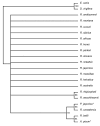Discovery and identification of a male-killing agent in the Japanese ladybird Propylea japonica (Coleoptera: Coccinellidae)
- PMID: 20149223
- PMCID: PMC2833154
- DOI: 10.1186/1471-2148-10-37
Discovery and identification of a male-killing agent in the Japanese ladybird Propylea japonica (Coleoptera: Coccinellidae)
Abstract
Background: Endosymbionts that manipulate the reproduction of their hosts have been reported widely in invertebrates. One such group of endosymbionts is the male-killers. To date all male-killers reported are bacterial in nature, but comprise a diverse group. Ladybirds have been described as a model system for the study of male-killing, which has been reported in multiple species from widespread geographic locations. Whilst criteria of low egg hatch-rate and female-biased progenic sex ratio have been used to identify female hosts of male-killers, variation in vertical transmission efficiency and host genetic factors may result in variation in these phenotypic indicators of male-killer presence. Molecular identification of bacteria and screening for bacterial presence provide us with a more accurate method than breeding data alone to link the presence of the bacteria to the male-killing phenotype. In addition, by identifying the bacteria responsible we may find evidence for horizontal transfer between endosymbiont hosts and can gain insight into the evolutionary origins of male-killing. Phylogenetic placement of male-killing bacteria will allow us to address the question of whether male-killing is a potential strategy for only some, or all, maternally inherited bacteria. Together, phenotypic and molecular characterisation of male-killers will allow a deeper insight into the interactions between host and endosymbiont, which ultimately may lead to an understanding of how male-killers identify and kill male-hosts.
Results: A male-killer was detected in the Japanese coccinellid, Propylea japonica (Thunberg) a species not previously known to harbour male-killers. Families produced by female P. japonica showed significantly female-biased sex ratios. One female produced only daughters. This male-killer trait was maternally inherited and antibiotic treatment produced a full, heritable cure. Molecular analysis identified Rickettsia to be associated with the trait in this species of ladybird.
Conclusion: We conclude that P. japonica is host to a bacterial male-killer that is vertically inherited with variable transmission efficiency. Rickettsia presence correlates with the male-killing trait, but there is some variation in the phenotypic expression of the trait due to interaction with host factors. Phylogenetic analysis using the 16S rRNA and 17 kDa antigen genes suggests there may have been horizontal transfer of Rickettsial male-killers between different ladybird hosts.
Figures



Similar articles
-
Incidence of male-killing Rickettsia spp. (alpha-proteobacteria) in the ten-spot ladybird beetle Adalia decempunctata L. (Coleoptera: Coccinellidae).Appl Environ Microbiol. 2001 Jan;67(1):270-7. doi: 10.1128/AEM.67.1.270-277.2001. Appl Environ Microbiol. 2001. PMID: 11133455 Free PMC article.
-
A new male-killing parasitism: Spiroplasma bacteria infect the ladybird beetle Anisosticta novemdecimpunctata (Coleoptera: Coccinellidae).Parasitology. 2006 Jun;132(Pt 6):757-65. doi: 10.1017/S0031182005009789. Epub 2006 Feb 3. Parasitology. 2006. PMID: 16454865
-
Male-killing bacterium in a fifth ladybird beetle, Coleomegilla maculata (Coleoptera:Coccinellidae).Heredity (Edinb). 1996 Aug;77 ( Pt 2):177-85. doi: 10.1038/hdy.1996.122. Heredity (Edinb). 1996. PMID: 8760399
-
The emerging diversity of Rickettsia.Proc Biol Sci. 2006 Sep 7;273(1598):2097-106. doi: 10.1098/rspb.2006.3541. Proc Biol Sci. 2006. PMID: 16901827 Free PMC article. Review.
-
Sex determination systems as the interface between male-killing bacteria and their hosts.Proc Biol Sci. 2022 Apr 13;289(1972):20212781. doi: 10.1098/rspb.2021.2781. Epub 2022 Apr 13. Proc Biol Sci. 2022. PMID: 35414231 Free PMC article. Review.
Cited by
-
Insect Sex Determination Manipulated by Their Endosymbionts: Incidences, Mechanisms and Implications.Insects. 2012 Feb 10;3(1):161-99. doi: 10.3390/insects3010161. Insects. 2012. PMID: 26467955 Free PMC article. Review.
-
Intergenomic arms races: detection of a nuclear rescue gene of male-killing in a ladybird.PLoS Pathog. 2010 Jul 8;6(7):e1000987. doi: 10.1371/journal.ppat.1000987. PLoS Pathog. 2010. PMID: 20628578 Free PMC article.
-
Two strains of male-killing Wolbachia in a ladybird, Coccinella undecimpunctata, from a hot climate.PLoS One. 2013;8(1):e54218. doi: 10.1371/journal.pone.0054218. Epub 2013 Jan 21. PLoS One. 2013. PMID: 23349831 Free PMC article.
-
Abundance and Localization of Symbiotic Bacterial Communities in the Fly Parasitoid Spalangia cameroni.Appl Environ Microbiol. 2022 May 10;88(9):e0254921. doi: 10.1128/aem.02549-21. Epub 2022 Apr 14. Appl Environ Microbiol. 2022. PMID: 35420439 Free PMC article.
-
Sex-ratio distortion in a weed biological control agent, Ceratapion basicorne (Coleoptera: Brentidae), associated with a species of Rickettsia.Environ Entomol. 2025 Feb 19;54(1):109-118. doi: 10.1093/ee/nvae115. Environ Entomol. 2025. PMID: 39541572 Free PMC article.
References
MeSH terms
Substances
LinkOut - more resources
Full Text Sources

